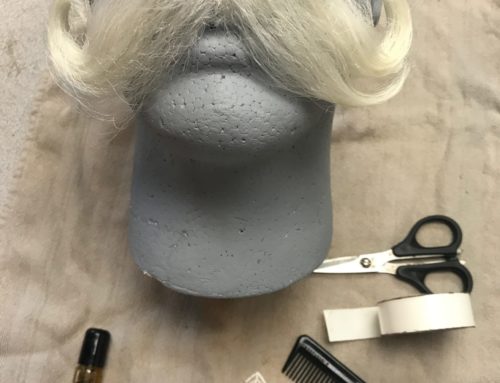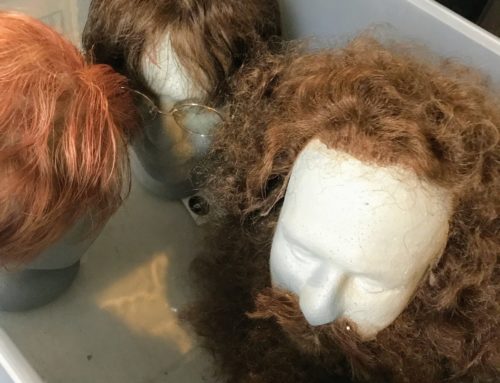Here’s a little something about one of my favorite topics, dyeing human hair brilliant, non-natural colors using good old union dyes!

Undead Ladies with Lavendar Hair – Amy Baldwin, Mike Ostroski, and Seana Hollingsworth in the Barter Theatre’s production of “Blithe Spirit”
There are many machine-made wigs available in a rainbow of colors – there’s no shortage of technicolor spikes, sassy burgundy bobs and fluroescent clown coiffures. But what do you do if you need a high-quality, human hair wig that looks as natural and believable as possible, but also needs to be emerald green, lavendar or acid red?While you can purchase wefts in a variety of non-traditional hues or purchase custom dyed hair from wig suppliers, it’s quite easy and quick to dye human hair to get just the right color.

In this photo from “Blithe Spirit”, you can see lavender wigs for the dead Ruth and Elvira, as well as their “living” hair colors. Because we see both the living and dead hair, I had an additional challenge in “translating” their hair colors into the grey/lavendar “dead” color scheme of their skin and clothes.
My first impulse was to simply dip two blonde human hair wigs into a pot lavendar dye and call it a day – after all, I knew that a standard union dye like RIT would tint human hair without causing damage to the strands.
However, I knew that I wanted to achieve the same level of subtle high and low lights in the “Dead” wigs that I had in the “Alive” wigs – so I mixed up several pots of dye in a range of lavendar and grey colors.
After that, it was simple matter to dip wefts of light blonde hair into the dye pots to achieve a range of hues. As with any dye project, leaving the hair in the pot for longer produced a more saturated color and less time in the pot resulted in a lighter color. I used this to produce lighter and darker shades of each hue.
Once I had the dyed wefts, I proceeded to build the wigs as I normally would.
So how do you dye human hair in a dye pot without damaging the hair? After all, human hair is fragile and susceptible to damage from heat and chemicals, both of which are present in most dye pots.
The key is to heat the water to near boiling in order to ensure that the dye is completely dissovled. I usually dissolve dye powder in a small amount of boiling water before adding it to the larger pot of water – this ensures an even dissolve of the dye powder. NOTE – There are many excellent resources on using dyes, so I recommend readers seek those out for in depth information on the nuts and bolts of dyes and dyeing.
Once the dye is sufficiently dissovled, and the bath is the desired color (I recommend testing your colors on swatches of white cotton), reduce it to low heat – you want the water to be hot enough to penetrate the hair, but not hot enough to damage it.
I have found that putting the hair to soak in water prior to dyeing helps the hair absorb dye more effectively.
As you let the wefts float in the dye pot, keep a close eye on the hair to ensure it doesn’t come into contact with the pot – the hot metal can burn the hair. I try not to put more than one piece of hair in the pot at a time to prevent tangling. Pull the hair out and check the color periodically – once you think it is nearly the color you want, rinse it thoroughly with cold water and then gently wring it out in a towel.
At this point, you will either find that the hair is the proper hue or you will find that it is ligher than you want (it is also possible that it could be darker than desired – but the color usually absorbs so gradually that I have never experienced this).
A note here on the color of the hair you are dyeing – I generally buy the lightest blonde hair (shade 613 on most rings) as it takes the dyed color most effectively – however you can dye any shade of human hair, if, for example, you want to give a purple tint to some brown hair. Be aware that, like fabric dyeing, the darker your hair starts out, the less the dyed color is going to show up. You can also buy white human or yak hair to dye – but these are both more expensive than platinum blonde. I only dye true white hair if I need the very lightest of pastel colors.
If it is too light, put it back in the bath until it is the correct color. If you’re pleased with the color, I suggest putting it to soak in a cold water bath that has a small amount of liquid fabric softner in it. This bath helps set the color and puts moisture back into the hair.
I usually let all of my dyed hair accumulate in this final bath until I am finished dyeing. Once I have all of the hair dyed, I remove it, rinse it and wring it out in a towel. At this point, you are either ready to let it air dry or you can give the hair an extra conditioning treatment, depending on your preference.I simply coat the hair with standard conditioner, let it soak in for up to 20 minutes, then rinse thoroughly and wring dry. At this point, the hair should be rinsing clean, and should not deposit color on any surface – I do a white towel test at this point, just to be sure the color is fast. In the event you’re experiencing any color bleed, rinse the hair again in fabric softner and repeat the conditioning.

The hair from the above picture was used to build this wig for “Sirens” at Actors Theatre of Louisville. This photo shows actor Lindsay Wochley in the first fitting for the wig, prior to styling.
From here, you should be able to use your dyed wefts as you would use any other piece of hair. For more information on the creation of the red Siren wig above, you can read the article I wrote, Making the Siren.






Leave A Comment